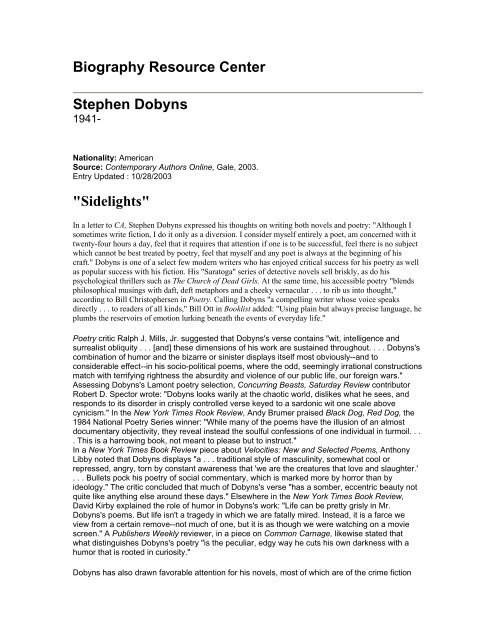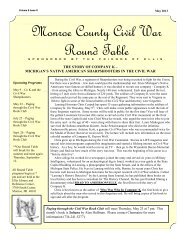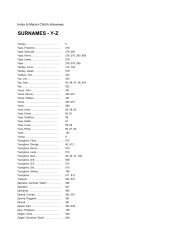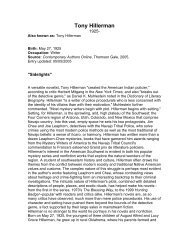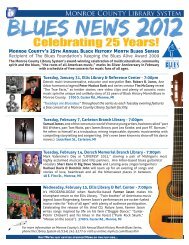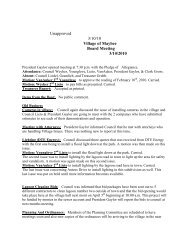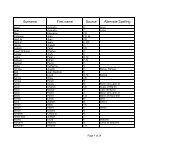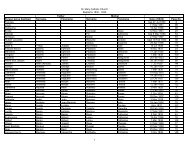Biography Resource Center Stephen Dobyns "Sidelights"
Biography Resource Center Stephen Dobyns "Sidelights"
Biography Resource Center Stephen Dobyns "Sidelights"
You also want an ePaper? Increase the reach of your titles
YUMPU automatically turns print PDFs into web optimized ePapers that Google loves.
<strong>Biography</strong> <strong>Resource</strong> <strong>Center</strong><br />
<strong>Stephen</strong> <strong>Dobyns</strong><br />
1941-<br />
Nationality: American<br />
Source: Contemporary Authors Online, Gale, 2003.<br />
Entry Updated : 10/28/2003<br />
"Sidelights"<br />
In a letter to CA, <strong>Stephen</strong> <strong>Dobyns</strong> expressed his thoughts on writing both novels and poetry: "Although I<br />
sometimes write fiction, I do it only as a diversion. I consider myself entirely a poet, am concerned with it<br />
twenty-four hours a day, feel that it requires that attention if one is to be successful, feel there is no subject<br />
which cannot be best treated by poetry, feel that myself and any poet is always at the beginning of his<br />
craft." <strong>Dobyns</strong> is one of a select few modern writers who has enjoyed critical success for his poetry as well<br />
as popular success with his fiction. His "Saratoga" series of detective novels sell briskly, as do his<br />
psychological thrillers such as The Church of Dead Girls. At the same time, his accessible poetry "blends<br />
philosophical musings with daft, deft metaphors and a cheeky vernacular . . . to rib us into thought,"<br />
according to Bill Christophersen in Poetry. Calling <strong>Dobyns</strong> "a compelling writer whose voice speaks<br />
directly . . . to readers of all kinds," Bill Ott in Booklist added: "Using plain but always precise language, he<br />
plumbs the reservoirs of emotion lurking beneath the events of everyday life."<br />
Poetry critic Ralph J. Mills, Jr. suggested that <strong>Dobyns</strong>'s verse contains "wit, intelligence and<br />
surrealist obliquity . . . [and] these dimensions of his work are sustained throughout. . . . <strong>Dobyns</strong>'s<br />
combination of humor and the bizarre or sinister displays itself most obviously--and to<br />
considerable effect--in his socio-political poems, where the odd, seemingly irrational constructions<br />
match with terrifying rightness the absurdity and violence of our public life, our foreign wars."<br />
Assessing <strong>Dobyns</strong>'s Lamont poetry selection, Concurring Beasts, Saturday Review contributor<br />
Robert D. Spector wrote: "<strong>Dobyns</strong> looks warily at the chaotic world, dislikes what he sees, and<br />
responds to its disorder in crisply controlled verse keyed to a sardonic wit one scale above<br />
cynicism." In the New York Times Rook Review, Andy Brumer praised Black Dog, Red Dog, the<br />
1984 National Poetry Series winner: "While many of the poems have the illusion of an almost<br />
documentary objectivity, they reveal instead the soulful confessions of one individual in turmoil. . .<br />
. This is a harrowing book, not meant to please but to instruct."<br />
In a New York Times Book Review piece about Velocities: New and Selected Poems, Anthony<br />
Libby noted that <strong>Dobyns</strong> displays "a . . . traditional style of masculinity, somewhat cool or<br />
repressed, angry, torn by constant awareness that 'we are the creatures that love and slaughter.'<br />
. . . Bullets pock his poetry of social commentary, which is marked more by horror than by<br />
ideology." The critic concluded that much of <strong>Dobyns</strong>'s verse "has a somber, eccentric beauty not<br />
quite like anything else around these days." Elsewhere in the New York Times Book Review,<br />
David Kirby explained the role of humor in <strong>Dobyns</strong>'s work: "Life can be pretty grisly in Mr.<br />
<strong>Dobyns</strong>'s poems. But life isn't a tragedy in which we are fatally mired. Instead, it is a farce we<br />
view from a certain remove--not much of one, but it is as though we were watching on a movie<br />
screen." A Publishers Weekly reviewer, in a piece on Common Carnage, likewise stated that<br />
what distinguishes <strong>Dobyns</strong>'s poetry "is the peculiar, edgy way he cuts his own darkness with a<br />
humor that is rooted in curiosity."<br />
<strong>Dobyns</strong> has also drawn favorable attention for his novels, most of which are of the crime fiction
genre. Washington Post Book World columnist Jean M. White cited <strong>Dobyns</strong>'s fiction for its "slyly<br />
quiet humor and tender feeling." In a Washington Post Book World review of Dancer with One<br />
Leg, Lawrence Block wrote of <strong>Dobyns</strong>: "His writing is honest, toughminded, and as<br />
uncompromising as his unforgettable hero. There's not a false sentence anywhere, not a moment<br />
where interest flags." Comparing <strong>Dobyns</strong> to Vladimir Nabokov in a Washington Post review of<br />
Cold Dog Soup, Carol E. Rinzler concluded: "[<strong>Dobyns</strong>] possesses a sensibility that is worth<br />
capturing in the amber of fiction, thoughtful but not devoid of sentiment, intelligent but not sterile."<br />
<strong>Dobyns</strong> is best known for his "Saratoga" series, a group of crime novels set in Saratoga Springs,<br />
New York, featuring a self-doubting detective named Charlie Bradshaw and his hedonistic<br />
sidekick, Victor Plotz. Many of the plots center around corruption in the horse racing industry, as<br />
Saratoga is a prominent stop on the thoroughbred racing schedule. <strong>Dobyns</strong> was among a group<br />
of detective writers who began to see their protagonists as mortals rather than stereotypes--<br />
Charlie Bradshaw has undergone a divorce, a great deal of self-recrimination, and a turbulent<br />
descent into middle age. In an interview with Booklist, <strong>Dobyns</strong> explained: "I don't like mystery<br />
heroes who are too perfect--characters who never have problems, or if they do, conquer them<br />
easily, and who have great secondary knowledge of subjects like wine or German shepherds. I<br />
wanted to write about a character who caught colds, who had problems with his car, whose<br />
marriage was falling apart--someone, in other words, who seemed far more realistic to me." Of<br />
Victor Plotz, who narrates several of the novels himself, <strong>Dobyns</strong> noted: "I'm sure he resembles<br />
many of my own darker qualities. . . . Working from his point of view is fun. Victor's jokes are a<br />
pleasure to write."<br />
New York Times Book Review correspondent Ann Arensberg declared: "<strong>Stephen</strong> <strong>Dobyns</strong>'s<br />
mystery novels have two major assets that accumulate high rates of interest from book to book:<br />
his setting, Saratoga Springs, and his private detective, Charlie Bradshaw. . . . Unlike most<br />
fictional detectives, who give the same flawless performance over and over again in a world<br />
outside time, Charlie is allowed by his creator to suffer changes and even to age. He is mortal,<br />
like us, and his struggles and successes matter."<br />
<strong>Dobyns</strong> is equally acclaimed for his darker psychological thrillers. In After Shocks, Near Escapes,<br />
he describes in harrowing detail the lasting effects of a devastating earthquake on one young<br />
Chilean girl and her extended family. The novel's narrator, Lucy Recabarren, looks back from a<br />
troubled adulthood to the events surrounding the earthquake, which forever altered her naïve<br />
certainties about existence. "Populating a historical catastrophe with fictional characters,<br />
[<strong>Dobyns</strong>] examines not so much the earthquakes in their past as the futures they project for<br />
themselves after the great disaster," Ron Loewinsohn observed in the New York Times Book<br />
Review. The critic added: "<strong>Stephen</strong> <strong>Dobyns</strong> is a writer with an impressive range. . . . He is mostly<br />
interested in the quake as a very provocative organizing metaphor: the ground we stand on, the<br />
present moment, is always unstable, always shaky."<br />
The author explores this theme further in his well-received The Church of the Dead Girls. A series<br />
of grisly murders in a small town provokes a level of paranoia and vigilante justice that might have<br />
seemed inconceivable to the heretofore complacent and "civilized" townspeople. "This chiller is<br />
about the awful power of fear," maintained a Publishers Weekly reviewer. "When the people of<br />
Aurelius go looking for a monster, monsters are all they can see." Booklist contributor Joanne<br />
Wilkinson praised the book as a "dark, cerebral thriller" in which <strong>Dobyns</strong> is "not as interested in<br />
the pathology of the serial killer . . . as he is in the pathology that exists within us all."<br />
The pathology of community is again dissected in Boy in the Water, a thriller set at a private<br />
academy in New Hampshire. Seeking release from the guilt he feels over the death of his wife<br />
and daughter in a house fire, Jim Hawthorne takes a job as headmaster at Bishop's Hill<br />
Academy, a school known for its wealthy but troubled student population. Despite his best efforts,<br />
Hawthorne finds that the staff and many of the students are conspiring against him--with deadly<br />
results. In his Booklist review of Boy in the Water, Bill Ott wrote: "This one adds elements of
gothic horror to the mix, and the result is absolutely compelling. . . . <strong>Dobyns</strong> not only scares us<br />
with what is out there but also with what we find (or don't find) within ourselves."<br />
The Wrestler's Cruel Study finds <strong>Dobyns</strong> in a more experimental vein. Pairing Nietzschian and<br />
Gnostic philosophies with professional wrestling and a tale of self-transformation, the story<br />
follows the adventures of a wrestler named Marduk the Magnificent as he searches for his<br />
abducted girlfriend. According to Sven Birkerts in the New York Times Book Review, the novel is<br />
"utterly preposterous, and quite serious . . . Indeed, such is Mr. <strong>Dobyns</strong>'s cunning that right when<br />
we think his novel has slipped into terminal silliness, he pulls us upright with some arresting<br />
metaphysical insight. And just when we are persuaded that the work is in fact a worthy meditation<br />
on good and evil, a banana peel appears underfoot and sends us sprawling." A Kirkus Reviews<br />
critic deemed the work "stunningly imaginative, so liberating in its sense of possibilities in life and<br />
art, and so much fun."<br />
<strong>Dobyns</strong>'s first collection of short stories, Eating Naked, plumbs the depths of human frailty<br />
through meditations on failed marriages, bizarre deaths, and dysfunctional families. Booklist<br />
correspondent Michele Leber felt that the short story format allows <strong>Dobyns</strong> "a show of ingenuity,<br />
even exuberance," as he "takes an idea, from the mundane to the bizarre, and runs with it." In the<br />
New Fiction Forum, Roger Boylan observed that the author "balances compassion, believability,<br />
and poignancy" in his tales. Boylan concluded: "These are finely-crafted, jarring stories that leave<br />
the reader with a sense of apprehension at the sheer craziness of what passes for everyday life.<br />
<strong>Dobyns</strong> at his best gives us a real chill when he lifts the curtain on what lies beyond."<br />
PERSONAL INFORMATION<br />
Family: Born February 19, 1941, in Orange, NJ; son of Lester L. (an Episcopal minister) and Barbara<br />
(Johnston) <strong>Dobyns</strong>; married; three children. Education: Attended Shimer College, 1959-60; Wayne State<br />
University, B.A., 1964; University of Iowa, M.F.A., 1967. Politics: Democrat. Religion: None. Addresses:<br />
Home:<br />
32 Warwick Rd., Watertown, MA 02172<br />
.<br />
AWARDS<br />
Concurring Beasts was a Lamont Poetry Selection for 1971; MacDowell Colony fellowships, 1972 and<br />
1976; Yaddo Colony fellowships, 1972, 1973, 1977, 1981 and 1982; National Endowment for the Arts<br />
fellowships, 1974 and 1981; Guggenheim fellowship, 1983; National Poetry Series winner, 1984, for Black<br />
Dog, Red Dog.<br />
CAREER<br />
State University of New York College at Brockport, instructor in English, 1968-69;<br />
• Detroit News, Detroit, MI, reporter, 1969-71; writer, 1971--. Visiting lecturer in creative writing,<br />
University of New Hampshire, 1973-75, University of Iowa, 1977-78, and Boston University, 1978-<br />
79. Member of staff, Goddard College, 1978-80, and Warren Wilson College, 1981.<br />
WRITINGS BY THE AUTHOR:
POETRY<br />
• Concurring Beasts, Atheneum (New York City), 1972.<br />
• Griffon, Atheneum, 1976.<br />
• Heat Death, Atheneum, 1980.<br />
• The Balthus Poems, Atheneum, 1982...<br />
• Black Dog, Red Dog, Holt (New York City), 1984.<br />
• Cemetery Nights, Viking (New York City), 1987.<br />
• A Boat off the Coast, Viking, 1987.<br />
• Body Traffic: Poems, Viking, 1990.<br />
• Velocities: New and Selected Poems, 1966-1992, Viking, 1994.<br />
• Common Carnage, Penguin Poets (New York City), 1996.<br />
• Pallbearers Envying the One Who Rides, Penguin Poets, 1999.<br />
• The Porcupine's Kisses, illustrations by Howie Michels, Penguin Poets (New York, NY),<br />
2002.<br />
Contributor to periodicals, including New Yorker, Nation, and Poetry; and also to anthologies,<br />
including Hammer and Blaze: A Gathering of Contemporary American Poets, edited by Ellen<br />
Bryant Voigt and Heather McHugh, University of Georgia Press, 2002; and Pleased to See Me:<br />
69 Very Sexy Poems, edited by Neil Astley, Bloodaxe Books, 2003.<br />
NOVELS<br />
• A Man of Little Evils, Atheneum, 1973.<br />
• Saratoga Longshot, Atheneum, 1976.<br />
• Saratoga Swimmer, Atheneum, 1981.<br />
• Dancer with One Leg, Dutton (New York City), 1983.<br />
• Saratoga Headhunter, Viking, 1985.<br />
• Cold Dog Soup, Viking, 1985.<br />
• Saratoga Snapper, Viking, 1986.<br />
• Saratoga Bestiary, Viking, 1988.<br />
• The Two Deaths of Senora Puccini, Viking, 1988.<br />
• Saratoga Hexameter, Viking, 1990.<br />
• The House on Alexandrine, Wayne State University Press (Detroit), 1990.<br />
• After Shocks, Near Escapes, Viking, 1991.<br />
• The Wrestler's Cruel Study: A Novel, W. W. Norton (New York City), 1993.<br />
• Saratoga Haunting, Viking, 1993.<br />
• Saratoga Backtalk, W. W. Norton, 1994.<br />
• Saratoga Trifecta, Penguin (New York City), 1995.<br />
• Saratoga Fleshpot, W. W. Norton, 1995.<br />
• The Church of Dead Girls, Metropolitan Books (New York City), 1997.<br />
• Saratoga Strongbox: A Charlie Bradshaw Mystery, Viking, 1998.<br />
• Boy in the Water, Metropolitan Books, 1999.<br />
SHORT STORIES<br />
• Eating Naked, Metropolitan Books, 2000.
OTHER<br />
• Best Words, Best Order: Essays on Poetry, St. Martin's (New York City), 1996, second<br />
edition, Palgrave Macmillan, 2003.<br />
• (Author of foreword) Michael Teig, Big Back Yard (A. Poulin, Jr. New Poets of America<br />
Series #25), BOA Editions, 2003.<br />
MEDIA ADAPTATIONS<br />
The Church of Dead Girls has been optioned by Home Box Office (HBO) for a feature film.<br />
FURTHER READINGS ABOUT THE AUTHOR:<br />
BOOKS<br />
• Stitt, Peter, Uncertainty and Plentitude: Five Contemporary Poets, University of Iowa<br />
Press (Iowa City, IA), 1997.<br />
PERIODICALS<br />
• Booklist, April 15, 1997, Joanne Wilkinson, review of The Church of Dead Girls, p. 1400;<br />
July, 1997, Bill Ott, "The Booklist Interview: <strong>Stephen</strong> <strong>Dobyns</strong>, " p. 1798; April 15, 1999,<br />
Bill Ott, review of Boy in the Water, p. 1472; April 1, 2000, Michele Leber, review of<br />
Eating Naked, p. 1432.<br />
• Library Journal, June 15, 1973; March 1, 1976; January 1, 1977.<br />
• New Fiction Forum, summer, 2000, Roger Boylan, "The Naked and the Dead, " pp. 31-<br />
33.<br />
• New York Times, April 19, 1985; December 2, 1988, John Gross, "Detectives Fighting<br />
Crime and Time, " p. C29.<br />
• New York Times Book Review, September 23, 1984; September 29, 1985; December 23,<br />
1990, David Kirby, "Life's Goofy Splendors"; July 21, 1991, Ron Loewinsohn, "Life on the<br />
Richter Scale"; July 4, 1993, Ann Arensberg, "The Body under Jacko's Pool Hall"; August<br />
15, 1993, Sven Birkerts, "Don't Mess with Marduk the Magnificent"; January 15, 1995,<br />
Anthony Libby, "One Gives Us 'Happiness'; The Other, 'Gluttony'"; June 22, 1997, David<br />
Walton, review of The Church of Dead Girls, p. 20; September 19, 1999, Erik Burns,<br />
review of Boy in the Water, p. 21.<br />
• Poetry, September, 1997, Bill Christophersen, review of Common Carnage, p. 347.<br />
• Publishers Weekly, February 26, 1996, review of Common Carnage, p. 101; April 28,<br />
1997, review of The Church of Dead Girls, p. 48; March 6, 2000, review of Eating Naked,<br />
p. 80.<br />
• Saturday Review, March 11, 1972.<br />
• Times Literary Supplement, July 29, 1977.<br />
• Washington Post, December 3, 1985.<br />
• Washington Post Book World, December 20, 1981; September 5, 1982; May 15, 1983;<br />
May 19, 1985.*
SOURCE CITATION<br />
Contemporary Authors Online, Gale, 2006. Reproduced in <strong>Biography</strong> <strong>Resource</strong> <strong>Center</strong>.<br />
Farmington Hills, Mich.: Thomson Gale. 2006. http://galenet.galegroup.com/servlet/BioRC<br />
Document Number: H1000025950


